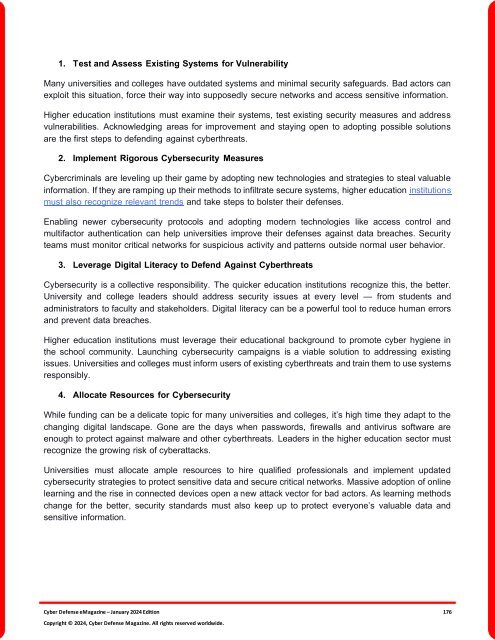The Cyber Defense eMagazine January Edition for 2024
Cyber Defense eMagazine January Edition for 2024 #CDM #CYBERDEFENSEMAG @CyberDefenseMag by @Miliefsky a world-renowned cyber security expert and the Publisher of Cyber Defense Magazine as part of the Cyber Defense Media Group as well as Yan Ross, Editor-in-Chief and many more writers, partners and supporters who make this an awesome publication! 201 page January Edition fully packed with some of our best content. Thank you all and to our readers! OSINT ROCKS! #CDM #CDMG #OSINT #CYBERSECURITY #INFOSEC #BEST #PRACTICES #TIPS #TECHNIQUES
Cyber Defense eMagazine January Edition for 2024 #CDM #CYBERDEFENSEMAG @CyberDefenseMag by @Miliefsky a world-renowned cyber security expert and the Publisher of Cyber Defense Magazine as part of the Cyber Defense Media Group as well as Yan Ross, Editor-in-Chief and many more writers, partners and supporters who make this an awesome publication! 201 page January Edition fully packed with some of our best content. Thank you all and to our readers! OSINT ROCKS! #CDM #CDMG #OSINT #CYBERSECURITY #INFOSEC #BEST #PRACTICES #TIPS #TECHNIQUES
Create successful ePaper yourself
Turn your PDF publications into a flip-book with our unique Google optimized e-Paper software.
1. Test and Assess Existing Systems <strong>for</strong> Vulnerability<br />
Many universities and colleges have outdated systems and minimal security safeguards. Bad actors can<br />
exploit this situation, <strong>for</strong>ce their way into supposedly secure networks and access sensitive in<strong>for</strong>mation.<br />
Higher education institutions must examine their systems, test existing security measures and address<br />
vulnerabilities. Acknowledging areas <strong>for</strong> improvement and staying open to adopting possible solutions<br />
are the first steps to defending against cyberthreats.<br />
2. Implement Rigorous <strong>Cyber</strong>security Measures<br />
<strong>Cyber</strong>criminals are leveling up their game by adopting new technologies and strategies to steal valuable<br />
in<strong>for</strong>mation. If they are ramping up their methods to infiltrate secure systems, higher education institutions<br />
must also recognize relevant trends and take steps to bolster their defenses.<br />
Enabling newer cybersecurity protocols and adopting modern technologies like access control and<br />
multifactor authentication can help universities improve their defenses against data breaches. Security<br />
teams must monitor critical networks <strong>for</strong> suspicious activity and patterns outside normal user behavior.<br />
3. Leverage Digital Literacy to Defend Against <strong>Cyber</strong>threats<br />
<strong>Cyber</strong>security is a collective responsibility. <strong>The</strong> quicker education institutions recognize this, the better.<br />
University and college leaders should address security issues at every level — from students and<br />
administrators to faculty and stakeholders. Digital literacy can be a powerful tool to reduce human errors<br />
and prevent data breaches.<br />
Higher education institutions must leverage their educational background to promote cyber hygiene in<br />
the school community. Launching cybersecurity campaigns is a viable solution to addressing existing<br />
issues. Universities and colleges must in<strong>for</strong>m users of existing cyberthreats and train them to use systems<br />
responsibly.<br />
4. Allocate Resources <strong>for</strong> <strong>Cyber</strong>security<br />
While funding can be a delicate topic <strong>for</strong> many universities and colleges, it’s high time they adapt to the<br />
changing digital landscape. Gone are the days when passwords, firewalls and antivirus software are<br />
enough to protect against malware and other cyberthreats. Leaders in the higher education sector must<br />
recognize the growing risk of cyberattacks.<br />
Universities must allocate ample resources to hire qualified professionals and implement updated<br />
cybersecurity strategies to protect sensitive data and secure critical networks. Massive adoption of online<br />
learning and the rise in connected devices open a new attack vector <strong>for</strong> bad actors. As learning methods<br />
change <strong>for</strong> the better, security standards must also keep up to protect everyone’s valuable data and<br />
sensitive in<strong>for</strong>mation.<br />
<strong>Cyber</strong> <strong>Defense</strong> <strong>eMagazine</strong> – <strong>January</strong> <strong>2024</strong> <strong>Edition</strong> 176<br />
Copyright © <strong>2024</strong>, <strong>Cyber</strong> <strong>Defense</strong> Magazine. All rights reserved worldwide.

















